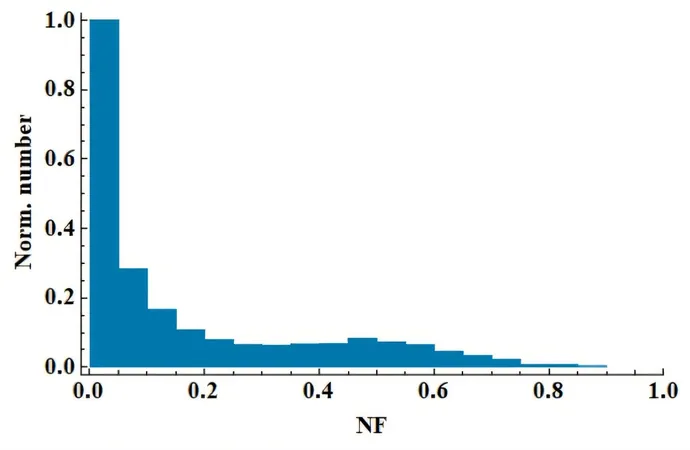
Revolutionary Insights into Pulsar Nulling: What the Stars Are Hiding!
2025-06-24
Author: Nur
Unlocking the Mysteries of Pulsar Emission!
A groundbreaking study emanating from the Xinjiang Astronomical Observatory, part of the Chinese Academy of Sciences, sheds light on the elusive phenomenon known as "pulse nulling." This intriguing occurrence, where radio emissions from pulsars suddenly halt, has been documented in over 200 instances.
What is Pulse Nulling?
Pulse nulling can last anywhere from merely a few rotations to several nerve-wracking minutes. While often perceived as random, the statistical patterns emerging from these events suggest there might be more depth to pulsar behaviors than previously thought.
Understanding the Nulling Fraction!
The scientists defined a term known as the nulling fraction (NF), which expresses the ratio of pulses exhibiting no detectable emissions. Interestingly, as this NF increases among pulsars, the sheer number of these pulsars declines, hinting at potential underlying rules governing the nulling phenomenon.
Cutting-edge Magnetospheric Modeling!
To unravel the complexities of nulling, researcher R. Yuen utilized an advanced magnetospheric model that proposes multiple emission states, each dictated by differing plasma charge densities. This imaginative approach operates under several key insights: pulse nulling indicates a complete cessation of emissions, triggered by plasma density dropping to zero in optimal conditions, with the emission region segmented into distinct areas where this switch occurs.
Exciting Simulation Results!
In a large-scale simulation involving 5,000 synthetic pulsars monitored over 1,000 rotations, researchers discovered a normalized distribution skewed positively toward higher NFs—strikingly consistent with observational data! These results bolster the idea that nulling is a rare event, emerging from unpredictable processes within a pulsar's magnetosphere.
The Geometry of Nulling!
Intriguingly, the study found little correlation between NF and a pulsar's obliquity angle—the tilt between its magnetic and rotational axes. However, a fascinating trend emerged: as the obliquity angle decreased, the number of pulsars experiencing nulling increased. Could this suggest a hidden geometric influence on nulling behavior?
The Future of Pulsar Research!
These revelations not only enhance our understanding of pulsars but also pave the way for further investigations into their enigmatic nature. The cosmic dance of these celestial bodies continues to captivate astronomers, inviting us to explore the universe's secrets!

 Brasil (PT)
Brasil (PT)
 Canada (EN)
Canada (EN)
 Chile (ES)
Chile (ES)
 Česko (CS)
Česko (CS)
 대한민국 (KO)
대한민국 (KO)
 España (ES)
España (ES)
 France (FR)
France (FR)
 Hong Kong (EN)
Hong Kong (EN)
 Italia (IT)
Italia (IT)
 日本 (JA)
日本 (JA)
 Magyarország (HU)
Magyarország (HU)
 Norge (NO)
Norge (NO)
 Polska (PL)
Polska (PL)
 Schweiz (DE)
Schweiz (DE)
 Singapore (EN)
Singapore (EN)
 Sverige (SV)
Sverige (SV)
 Suomi (FI)
Suomi (FI)
 Türkiye (TR)
Türkiye (TR)
 الإمارات العربية المتحدة (AR)
الإمارات العربية المتحدة (AR)